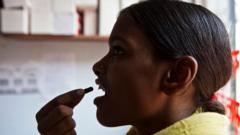

India is facing a grim paradox in its fight against deadly superbugs: while antibiotic overuse fuels resistance, a significant portion of the population lacks access to these life-saving drugs when they are most needed. This creates a perfect storm where superbugs thrive, leading to increased morbidity and mortality, especially among vulnerable populations.
A recent study by the Global Antibiotic Research and Development Partnership (GARDP), published in The Lancet Infectious Diseases, highlights this critical issue. The study, which examined nearly 1.5 million cases of carbapenem-resistant Gram-negative (CRGN) infections across eight low- and middle-income countries, including India, revealed that only 6.9% of patients received appropriate treatment. CRGN bacteria are resistant to last-line antibiotics, making them incredibly difficult to treat.
India, bearing the largest burden of CRGN infections in the study, procured 80% of the full courses of the studied antibiotics but only managed to treat 7.8% of its estimated cases. This stark contrast underscores the challenges in ensuring that available antibiotics reach those who need them most. According to Dr. Abdul Gaffar, an infectious disease consultant at Apollo Hospital in Chennai, "We often see patients for whom no antibiotic works - and they die."
Gram-negative bacteria, commonly found in water, food, and the environment, can cause severe infections like urinary tract infections (UTIs), pneumonia, and food poisoning. These infections pose a significant threat to newborns, the elderly, and hospital patients with weakened immune systems, often spreading rapidly in intensive care units (ICUs).
Several factors contribute to this complex problem. Overuse and misuse of antibiotics in humans and livestock have driven the rise of antimicrobial resistance (AMR). Easy over-the-counter availability of antibiotics, self-medication, and a lack of awareness about proper usage exacerbate the issue. A nationwide survey by the Indian Council of Medical Research (ICMR) revealed high resistance rates to last-resort antibiotics among common bloodstream infections.
Inadequate access to diagnostic tests further compounds the problem, leading to inappropriate antibiotic prescriptions. The World Health Organization (WHO) has recognized this gap and published an essential diagnostics list, urging India to boost its laboratory infrastructure for comprehensive diagnostic services.
Recognizing the severity of the crisis, India has taken steps to combat AMR. New national guidelines on antibiotic use have been issued, and the central government plans to centralize the approval process for manufacturing antibiotics, aiming to enhance regulatory oversight and curb misuse. The Indian Medical Association (IMA) has also launched campaigns to sensitize healthcare professionals and the public on responsible antibiotic use.
Despite these efforts, challenges remain. The pipeline of new antibiotics is drying up globally, and access alone won't solve the crisis. Experts emphasize the need for smarter policies, stronger safeguards, and a focus on infection prevention and control measures, including improved sanitation and hygiene.
India's strong pharmaceutical base and emerging AMR innovation hub offer hope. Local development of new drugs and advanced diagnostics, coupled with data-driven strategies to address care pathway gaps, can strengthen the country's response to this growing threat. Several Indian companies are developing new antibiotics, some of which have shown promising results in clinical trials.
The fight against superbugs in India requires a multi-pronged approach that addresses both access and misuse. By promoting responsible antibiotic use, strengthening diagnostic capabilities, and fostering innovation in drug development, India can mitigate the devastating impact of AMR and protect its population from these deadly infections.